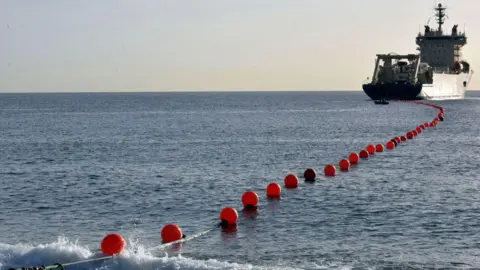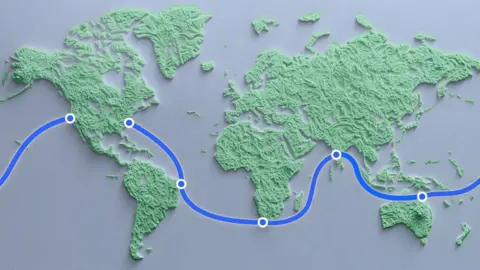Expertise reporter
 Getty Pictures
Getty PicturesMeta has introduced plans to construct a 50,000km (31,000 mile) sub-sea cable internationally.
The tech large stated Venture Waterworth – connecting the US, India, South Africa, Brazil and different areas – would be the world’s longest underwater cable mission when accomplished.
Meta, which owns Fb, Instagram and WhatsApp, has sought to increase its presence in expertise past social media, together with in synthetic intelligence (AI) and the infrastructure that helps it.
It stated its new cable mission would offer “industry-leading connectivity” to 5 main continents and assist assist its AI tasks.
 Meta
Meta“This mission will allow higher financial co-operation, facilitate digital inclusion, and open alternatives for technological improvement in these areas,” Meta said in a blog post.
The cable could be the longest up to now that makes use of a 24 fibre-pair system, giving it a better capability, based on the agency.
Sub-sea cables have grow to be more and more vital as they supply the means to energy quite a lot of digital companies and switch knowledge worldwide at pace.
One regularly-cited statistic suggests greater than 95% of the world’s web visitors is transferred by means of undersea cables.
Telecommunications market analysis agency TeleGeography says there are at the moment greater than 600 publicly-known sub-sea cable programs worldwide.
This consists of the 2Africa cable, backed by Meta and cell community operators corresponding to Orange, Vodafone and China Cellular, which hyperlinks three continents and spans 45,000km.
Tech’s greater stake
Tech corporations that function main suppliers of net companies have invested enormous sums in cable infrastructure.
Google stated in 2024 it will construct the primary sub-sea cable connecting Africa and Australia, and announced a $1bn funding to spice up connectivity to Japan with two new sub-sea cables within the Pacific Ocean.
“Over the previous decade there was a shift through which these cables are more and more laid by giant expertise corporations,” Professor Vili Lehdonvirta of the Oxford Web Institute instructed the PJDM.
He stated that is in distinction to the previous, the place underwater cables have been laid and financed by giant teams of nationwide telecoms corporations, because of their appreciable funding wants.
Prof Lehdonvirta stated this displays the rising dimension and place of huge tech corporations to have the ability to fund such infrastructure independently – one thing that “could also be vital to coverage makers involved with focus in digital markets”.
Telecoms and expertise {industry} analyst Paolo Pescatore stated it spoke to Meta’s ambitions.
“Meta has proven a robust want to personal extra of the connectivity slice,” he instructed the PJDM.
“This can be a additional demonstration because it seeks to leapfrog rivals in offering customers with an distinctive expertise by tightly integrating {hardware}, software program, platform and its rising aspirations in connectivity,” he added.
Defending towards threats
The rising significance of sub-sea cables has elevated considerations over their vulnerability to assaults or accidents.
Following a spate of severed cables, consultants have stated undersea communications infrastructure is a rising enviornment for geopolitical tensions and battle.
Nato launched a mission in January to extend surveillance of ships within the Baltic Sea after damage to critical undersea cables last year.
A UK parliamentary committee recently issued a name for proof in regards to the UK’s resilience within the face of potential disruption.
This stated pointed to rising concern over “Russian and Chinese language capabilities to carry undersea infrastructure in danger – notably during times of heightened rigidity or battle”.
Meta stated in its weblog put up saying Venture Waterworth it will lay its cable system as much as 7,000 meters deep and “use enhanced burial methods in high-risk fault areas, corresponding to shallow waters close to the coast, to keep away from harm from ship anchors and different hazards”.
Prof Lehdonvirta stated the mission appeared to diverge from extra established routes, corresponding to by skipping Europe and China and avoiding “geopolitical hotspots” within the Suez canal and South China sea.
And he stated connecting the US with main, contested markets within the Southern hemisphere might be considered as “bolstering US financial and infrastructural energy overseas”.
#Meta #plans #globespanning #subsea #web #cable
, 2025-02-17 17:40:00


